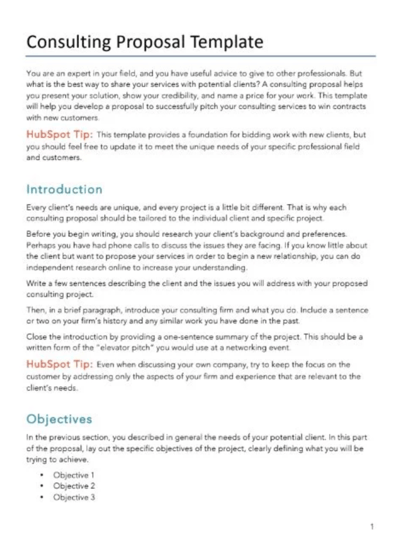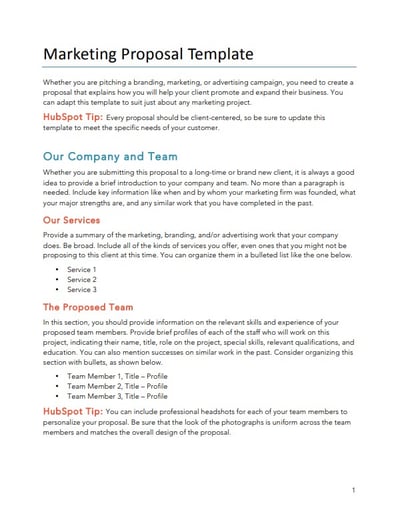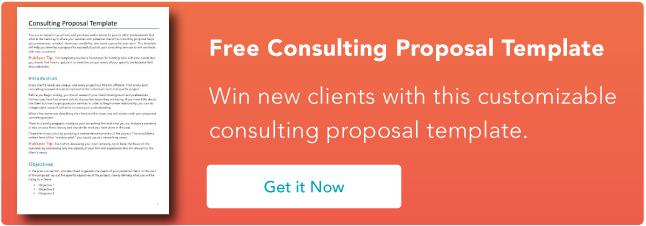You’ve just wrapped up a call with a prospective consulting client. They’re interested in working with you. Congratulations!
If you’ve found your way to this blog post, it’s safe to assume you now need to develop a consulting proposal for this client — and you need help doing so.
Many prospective clients request proposals before officially signing on the dotted line. Why? In short, a consulting proposal outlines your working relationship so that both parties can stay aligned and understand the other’s expectations. Proposals aren’t paper formalities — they signify the start of an important client-consultant relationship.
In this post, I’ll explain what a consulting proposal is and how to write one that your prospective clients can’t resist.
This document will effectively take your conversations with the prospect into an active working relationship. That’s why it’s important to write a good proposal.
A good consulting proposal must have the following information:
- A summary of the problems or challenges that your prospect is facing.
- A detailed account of how you’ll solve those problems.
- A list of the results you’ll seek to achieve for their business.
It also includes contractual information such as fees and terms.
Knowing how to write a clear, concise consulting proposal can make or break your ability to convert prospective clients. Let’s review how to pull together a winning proposal.
1. Chat with your client in person or over the phone.
You can’t write an effective consulting proposal without chatting with your prospective client first. Do your best to set up a phone call for this conversation; if you can, meet in person. Email will suffice for getting to know your client and their consulting needs, but letting them see your face and/or hear your voice will help you build trust with them.
2. Understand their challenges and needs.
The better you understand your prospective client’s challenges and pain points, the more impactful your proposal can be. While a consulting proposal template can help get the job done, the details in your proposals should not be one-size-fits-all; they should be tailored to each client and their needs. Don’t hesitate to follow up with additional phone calls or meetings to better understand your client and what they need from you.
3. Ask about the details.
A successful proposal reflects the project scope and details to keep both parties aligned. Don’t forget to ask about your client’s ideal timeline, budget, expectations, and outcomes. These details are important for selling a prospective client on your services as well as giving your client a better understanding of how exactly you two will work together.
4. Focus on client outcomes, not consultant input.
While it may be tempting to hone in on your qualifications and experience, your consulting proposal should focus on what your client will get from working with you. Be as specific as possible about the value and outcomes your client can expect. Also, avoid buzzwords and generic jargon. In fact, do your best to use the same words they did in your meetings — this will resonate with them and show you were listening.
5. Keep it short.
When it comes to consulting proposals, quality matters much more than quantity. Keep your proposal as brief as possible to accurately describe the project scope and expectations. Don’t give your client a reason to stop reading your proposal and potentially view another consultant’s — instead, keep your proposal concise and engaging. For reference, the average length is one to two pages long.
6. Always highlight your value proposition.
Hiring a consultant is not a cheap investment, and you want your client to understand that they’re investing in you because you’ll deliver results. You don’t necessarily need to include a section titled “Value Proposition,” either. Instead, at every step of the way, mention how you’ll be increasing X metric, reducing Y negative outcome, or driving Z results for their business.
7. Ask for feedback.
A consulting proposal is a two-way document, meaning both parties should have a say in the content it includes. As you develop your proposal, clarify any questions or concerns you have with your prospective client. When finished, send it to your client for review and feedback.
Consider building your proposal in Google Docs or a similar word processor in which your client can collaborate and leave comments or suggestions.
Sample Consulting Proposal
The most effective consulting proposals follow an engaging and logical structure. In this section, we’ll discuss the anatomy of a well-written consulting proposal.
1. Salutation
Begin your document by greeting your client.
A personalized greeting sets apart your consulting proposals from a generic proposal. When you treat your proposal as a personal letter, prospective clients are more likely to trust you and want to build a relationship with you. Use the client’s formal name (e.g. “Mr.,” “Mrs.,” or “Dr.”) unless you’re on a first-name basis.
2. Introduction
In this section, write 3 to 4 sentences describing the nature of the project and the issues you want to solve.
Consider this section the introduction, or hook, of your proposal. Summarize the challenges your prospective client is facing and what value you can provide through your consulting services. In this section, you should also thank your client for considering you and give them a brief overview of what they can expect from the rest of the proposal.
You can also include one to two sentences introducing yourself and your business. While the proposal shouldn’t be focused on your work as a consultant, it never hurts to include a short section in which you explain why the client should choose you. Even if you pitched yourself during your initial prospective call, you can reiterate your key strengths and qualifications here.
3. Project Scope
Next, add 3 to 5 bullet points giving insight into the exact action items (or tasks) you’ll undertake to achieve the desired result.
This section is all about what you’ll be doing to carry out the project you outlined above. Specificity is key here — unless you clearly outline what you’ll be doing for your client, you may experience scope creep.
For example, if you’re being hired to review and analyze a client’s marketing strategies, this section would outline how long your phone calls or office visits will be, how many calls or visits you commit to each week, the length of each visit, etc. You can never be too detailed in the project scope section; it’ll only save you and your client a headache later.
4. Objectives
In this section, you’ll want to list out 3 to 5 objectives for the project.
Now that you’ve covered both the purpose and scope of the project, it’s time to convince the client of the project’s value. What sort of results do you want your client to see after they’re done working with you?
Unlike the deliverables section below, which focuses on the actual “final products” you’ll be delivering, the objectives section focuses on the end result after those products are delivered. It’s important to put this as early as possible in your document so that your client is convinced they’re making a good investment.
5. Deliverables
Next, list out the concrete deliverable(s) the client will have once they’re finished working with you. Will it be a revamped website? A redesigned collection of brochures?
This section outlines the tangible, identifiable end “products” you will be providing your client as a result of the project. If the project scope describes “how,” the deliverables are the “what.”
Following the example from above, while your project scope would be reviewing and analyzing marketing strategies, your deliverables may be a detailed analysis document, a presentation of proposed changes, or even a brand new marketing plan. (The specific details will vary depending on your client and their preferences and needs.)
6. Timeline
In this section, give a timeline for each specific action item you listed in the “Scope” section.
This section is incredibly important for setting expectations and creating boundaries with clients. If the project scope describes “how” and the deliverables outline the “what,” can you guess what the timeline section is? Ding, ding — it’s the “when”.
The timeline part of the proposal should outline specific project dates and deadlines for different parts of your project. Whether you’re making office visits, creating documents, or simply sending follow-up emails, try to detail every possible date in your proposal. At the very least, make sure you include the project start, final project deadlines, and any milestones in between.
7. Investment
Next, list out your consulting fees and what they include, as well as how and when you prefer to get paid.
If you recommend using a certain payment portal, include that information here. Similarly, if you require a down payment or staggered fee structure, don’t forget that information, too.
8. Signature
In this section, you’ll immediately ask for a signature from your prospective client. Include space for them to write the day’s date, their name, and their signature.
You’ll want to include this straight in the proposal, even if they’re still in the consideration stage, so that it’s easier to get approval. If you add the additional step of having to send a “finalized contract,” you risk unnecessarily elongating the process.
9. Next Steps
Last, include a strong call-to-action in your proposal. Leave your email for them to contact you as well. Give clear instructions in this final section so clients know how to move forward.
While each proposal you create should be tailored to each prospective client, it can be tedious to write out the entire document every time.
This is where a consulting proposal template can come in handy. Below you’ll find two consulting proposal templates: one for sales and the other for marketing.
Consulting Proposal Template for Sales
You can use this free consulting proposal template in Word or PDF format. The sections match up with what we covered above, but are worded a little differently to better align with sales.
Note: If you use a template, don’t forget to double-check that all client-specific details are updated and correct!
Featured Resource: Free Consulting Proposal Template

Download the Template for Free
This proposal template includes the following sections:
- Introduction: Describe the nature of the project and introduce yourself and what you do.
- Objectives: List out the goals for the project.
- Approach: Summarize your methodology for achieving the desired results and list the specific tasks you’ll undertake.
- Schedule of Project Activities: The equivalent of a “Timeline” section, you’ll use this space to describe when project tasks will be completed.
- The Team: List out any additional team members, as well as their qualifications.
- Your Investment: Lay out in clear terms what the client will be paying for.
- Signatures: Seal the deal by inviting the client to sign right away.
- Appendices: If you have specific terms and conditions for your services, include them here.
Consulting Proposal Template for Marketing
Proposals are especially critical in marketing. With so many areas of specialization, channels, deliverable types, and metrics to keep up with, you’ll need to set expectations for the relationship between you and the client.
A consulting proposal for marketing might include an outline of your strategic framework, the overall goals, and perhaps even the smaller milestones you want to be measured by. This free marketing proposal template is a great place to start.
Featured Resource: Free Marketing Consulting Proposal Template
 Download the Template for Free
Download the Template for Free
This proposal template includes the following sections:
- Our Company and Team: In this section, you’ll give a thorough overview of your business by providing a list of your services and proposed team for the project.
- Project Scope: Summarize the project in its entirety. You’ll write a short summary, a proposed solution, and a description of projected outcomes.
- Project Schedule: List out the different stages of the project with their start and completion dates.
- Your Investment: Outline what the client will be paying for in an itemized table.
- Contact Us: Give the client an opportunity to contact you by listing your information here.
- Contract and Signatures: Streamline the process by inviting the client to sign right away.
- Additional Materials: If you want to include case studies, portfolio items, or testimonials, include them here.
Feeling stuck? Let’s take a look at a consulting proposal example. To adapt this example for your own use, simply replace the mentions of the specific project with what you’ll actually be doing for your client.
Consulting Proposal Example
Tamara Akingbola
Hotel One
123 Hotel Street, Office #123
City, State 12345
December 1, 20XX
Your Name
Consultancy Name
123 Consulting Street, Office #123
City, State 12345
Consulting Proposal
Dear Mrs. Akingbola,
It’s a pleasure to work with you on the website marketing project we discussed over the phone. I look forward to growing your website’s organic traffic at a sustained scale, helping you boost bookings and reservations, and improving the bottom line at your hotel.
In this proposal, I’ll go over a brief project summary, cover the project’s scope, share deliverables, outline a timeline, and give more details about your investment. I’ll also provide some quick next steps.
Summary
The purpose of this project is to grow organic traffic for Hotel One’s website. Due to increasing competition, older content marketing practices, and reports of a clunky user experience, the business has suffered from a marked decrease in organic traffic, which has reduced reservations and, therefore, revenue.
My digital marketing consulting firm specializes in cases just like yours. I have more than ten years of experience driving results for small businesses in the hospitality industry. My last client, Hotel Two, saw a 233% increase in bookings YoY after I worked with them.
Project Scope
To grow organic traffic and achieve sustained growth, I will be undertaking the following tasks.
- Complete a comprehensive content and technical audit of the entire website.
- Carry out usability tests on a user testing platform to check what’s currently working and what’s not.
- Consult with you as I create a new and improved content strategy.
- Hire two freelance writers to rewrite the entire website.
- Bring in the expertise of a web developer to design a modern and search-engine-optimized website.
Objectives
The objectives of the project are as follows.
- Publish relevant, keyword-optimized content that drives more users to the reservation page.
- Improve the UX of the site both in the front- and back-end.
- Increase the average ranking for target keywords by at least 2 spots.
- Get on the first page of Google SERPs for at least 20% of the target keywords.
- Redesign the entire website so that it exceeds current design and usability standards.
Deliverables
You’ll receive five deliverables from me.
- A PDF document with my findings from the content and technical audit.
- A presentation with findings from the usability tests and suggested improvements.
- A new content plan that will be approved by you prior to execution.
- An editable copy of both the rewritten and newly-written website pages.
- An entirely redesigned website with the new content and technical improvements in place.
Timeline
The estimated completion time for the entire project is six months.
| Activity | Start Date | Completion Date |
| Content Audit | January 1 | January 14 |
| Technical Audit | January 15 | January 31 |
| Usability Tests | February 1 | February 7 |
| Content Plan Creation | February 8 | February 28 |
| Content Plan Review and Approval | March 1 | March 7 |
| Content Creation | March 8 | April 30 |
| Website Redesign | April 1 | June 1 |
Investment
I charge fees per project based on estimated time to completion.
You won’t have to worry about hiring freelance writers or finding a web developer. As your consultant, I’ll take care of that for you. All fees are inclusive of phone calls and emails.
| Project Activity | Hours | Fee |
| Content and Technical Audit | 30 | $900 |
| Usability Tests | N/A | $200 |
| Content Plan Creation | 30 | $900 |
| Content Creation | 100 | $3,000 |
| Website Redesign | 100 | $3,000 |
| Total | $8,000 |
Signature
Please sign below.
[signature form]
Next Steps
Please return the signed document to me by Wednesday, December 6. I’ll touch base with you on Friday, December 8, to discuss this proposal. You can send me any questions and concerns at [email protected]. I look forward to working with you.
Create a Consulting Proposal to Win More Clients
A well-written consulting proposal not only serves as a guidepost for a consultant-client relationship, but it can help convert prospects into loyal, long-term clients. Implement these consulting proposal best practices and start developing winning proposals for your consulting business.
Editor’s note: This post was originally published in December 2019 and has been updated for comprehensiveness.

![]()

![You are currently viewing How to Write a Consulting Proposal [Template]](https://www.dimaservices.agency/wp-content/uploads/2021/06/46d46c9b-bd8f-4aa6-b239-a7db137df24a.png)

